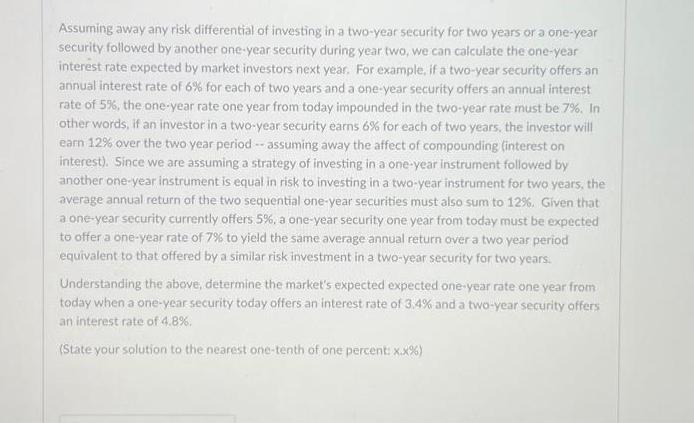Answered step by step
Verified Expert Solution
Question
1 Approved Answer
Assuming a borrower purchases a two-year zero-coupon bond with a face value of $1,000 for $769.46, what is bond's yield-to-maturity? (State your solution in



Assuming a borrower purchases a two-year zero-coupon bond with a face value of $1,000 for $769.46, what is bond's yield-to-maturity? (State your solution in percentage form rounded to the nearest percent.) Assuming that both the real rate (r) and expected rate of inflation (n") are significant, and accordingly, should be considered, calculate the nominal rate of return (1) that an investor would need to realize in order to make a 4% real return (r) in an economy with an inflation rate (n) of 16%. (Hint: use decimal values and the "precise formulation of the Fisher equation" in arriving at your solution.) Assuming away any risk differential of investing in a two-year security for two years or a one-year security followed by another one-year security during year two, we can calculate the one-year interest rate expected by market investors next year. For example, if a two-year security offers an annual interest rate of 6% for each of two years and a one-year security offers an annual interest rate of 5%, the one-year rate one year from today impounded in the two-year rate must be 7%. In other words, if an investor in a two-year security earns 6% for each of two years, the investor will earn 12% over the two year period -- assuming away the affect of compounding (interest on interest). Since we are assuming a strategy of investing in a one-year instrument followed by another one-year instrument is equal in risk to investing in a two-year instrument for two years, the average annual return of the two sequential one-year securities must also sum to 12%. Given that a one-year security currently offers 5%, a one-year security one year from today must be expected to offer a one-year rate of 7% to yield the same average annual return over a two year period equivalent to that offered by a similar risk investment in a two-year security for two years. Understanding the above, determine the market's expected expected one-year rate one year from today when a one-year security today offers an interest rate of 3.4% and a two-year security offers an interest rate of 4.8%. (State your solution to the nearest one-tenth of one percent: x.x%)
Step by Step Solution
There are 3 Steps involved in it
Step: 1

Get Instant Access to Expert-Tailored Solutions
See step-by-step solutions with expert insights and AI powered tools for academic success
Step: 2

Step: 3

Ace Your Homework with AI
Get the answers you need in no time with our AI-driven, step-by-step assistance
Get Started


